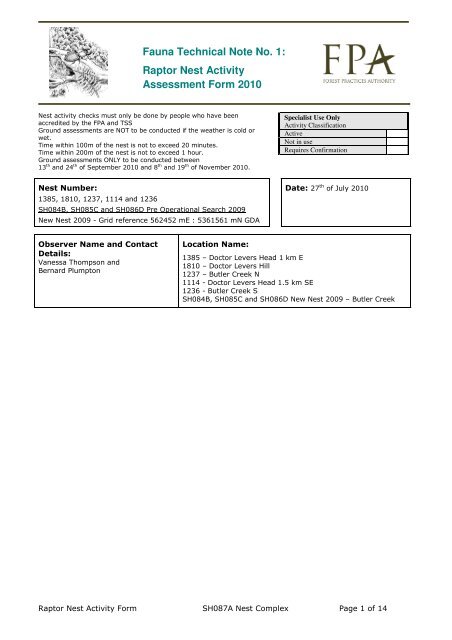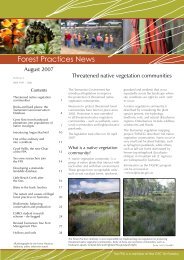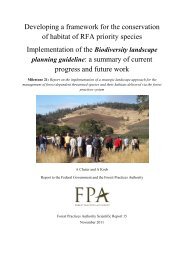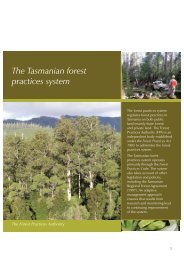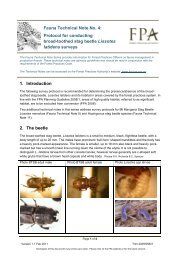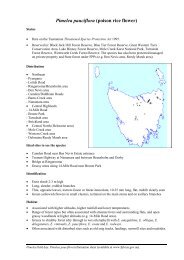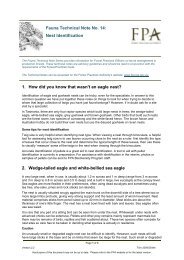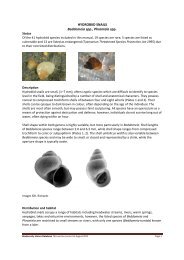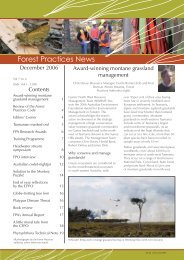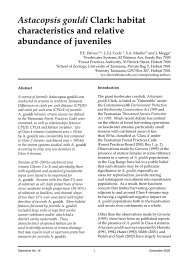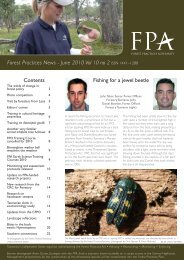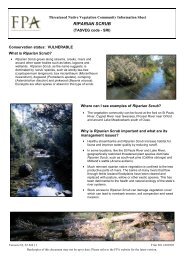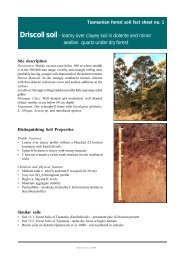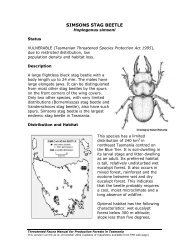Raptor Nest Activity Assessment Form 2010
Raptor Nest Activity Assessment Form 2010
Raptor Nest Activity Assessment Form 2010
Create successful ePaper yourself
Turn your PDF publications into a flip-book with our unique Google optimized e-Paper software.
Fauna Technical Note No. 1:<br />
<strong>Raptor</strong> <strong>Nest</strong> <strong>Activity</strong><br />
<strong>Assessment</strong> <strong>Form</strong> <strong>2010</strong><br />
<strong>Nest</strong> activity checks must only be done by people who have been<br />
accredited by the FPA and TSS<br />
Ground assessments are NOT to be conducted if the weather is cold or<br />
wet.<br />
Time within 100m of the nest is not to exceed 20 minutes.<br />
Time within 200m of the nest is not to exceed 1 hour.<br />
Ground assessments ONLY to be conducted between<br />
13 th and 24 th of September <strong>2010</strong> and 8 th and 19 th of November <strong>2010</strong>.<br />
Specialist Use Only<br />
<strong>Activity</strong> Classification<br />
Active<br />
Not in use<br />
Requires Confirmation<br />
<strong>Nest</strong> Number:<br />
1385, 1810, 1237, 1114 and 1236<br />
SH084B, SH085C and SH086D Pre Operational Search 2009<br />
New <strong>Nest</strong> 2009 - Grid reference 562452 mE : 5361561 mN GDA<br />
Date: 27 th of July <strong>2010</strong><br />
Observer Name and Contact<br />
Details:<br />
Vanessa Thompson and<br />
Bernard Plumpton<br />
Location Name:<br />
1385 – Doctor Levers Head 1 km E<br />
1810 – Doctor Levers Hill<br />
1237 – Butler Creek N<br />
1114 - Doctor Levers Head 1.5 km SE<br />
1236 - Butler Creek S<br />
SH084B, SH085C and SH086D New <strong>Nest</strong> 2009 – Butler Creek<br />
<strong>Raptor</strong> <strong>Nest</strong> <strong>Activity</strong> <strong>Form</strong> SH087A <strong>Nest</strong> Complex Page 1 of 14
Environmental Variables<br />
Estimated Temperature: 5 - 6 degrees<br />
Fine Overcast Showers (Please bold)<br />
Notes<br />
<strong>Nest</strong> inspected by air employing a<br />
helicopter. Conditions were generally<br />
overcast through entire inspection. The<br />
day however was generally still.<br />
Grid Reference GDA<br />
<strong>Nest</strong> Number: 1385<br />
Observation point:<br />
East: (6) 562195 mE East: (6) mE<br />
North: (7) 5363897 mN North: (7) mN<br />
<strong>Nest</strong> Number: 1810<br />
Observation point:<br />
East: (6) 561888 mE East: (6) mE<br />
North: (7) 5363162 mN North: (7) mN<br />
(hh:mm)<br />
<strong>Nest</strong> Number: 1237<br />
Observation point:<br />
East: (6) 561721 mE East: (6) mE<br />
North: (7) 5362921 mN North: (7) mN<br />
<strong>Nest</strong> Number: 1114<br />
Observation point:<br />
East: (6) 561903 mE East: (6) mE<br />
North: (7) 5362539 mN North: (7) mN<br />
<strong>Nest</strong> Number: 1236<br />
Observation point:<br />
East: (6) 561786 mE East: (6) mE<br />
North: (7) 5362090 mN North: (7) mN<br />
<strong>Nest</strong> Number: New <strong>Nest</strong> 2009 Observation point:<br />
East: (6) 562452 mE East: (6) mE<br />
North: (7) 5361561 mN North: (7) mN<br />
Notes<br />
Observation point is not in this instance applicable as inspection<br />
made from air above the nest location.<br />
(hh:mm)<br />
Start Time : 15:50 Finish Time : 16:03 Duration: 13 minutes<br />
This includes inspection of all six nests and<br />
location of new nest<br />
<strong>Nest</strong> Description:<br />
Provide any further comments relating to what was observed<br />
Note: Be specific in your description. Comments such as “nest untidy”<br />
(common to all nests) provide little detail<br />
<strong>Nest</strong> 1385<br />
<strong>Nest</strong> was found to be in excellent condition.<br />
The last inspection of this nest occurred on the<br />
8 th of July 2009 during aerial search activity in<br />
this area.<br />
There does not appear to have been any<br />
substantial changes in the size of this nest in the<br />
intervening period. The nest on the day of this<br />
inspection however was found to display multiple<br />
signs of maintenance activity and therefore<br />
expected use during the <strong>2010</strong> breeding season.<br />
Based on observation this nest on this day this<br />
nest should be considered active status leading<br />
into the <strong>2010</strong> breeding season.<br />
Were any of these observed on the nest<br />
Each box MUST be marked Yes/No or Not Assessed<br />
Green Leaves<br />
Yes<br />
Fresh (brown) sticks<br />
Yes<br />
White wash (droppings)<br />
Not observed<br />
Flat compressed nest top<br />
No<br />
<strong>Nest</strong> Bowl (concave nest platform) Yes<br />
Brown leaves on nest<br />
Down on/around nest<br />
<strong>Nest</strong> Partly/mostly bleached<br />
<strong>Nest</strong> condition<br />
Poor/average/good/excellent<br />
Prey remains<br />
Bird on nest or nearby<br />
(note age if possible)<br />
Yes<br />
No<br />
Mostly Bleached<br />
Excellent<br />
No<br />
No<br />
If the nest has no vantage points or you believe the<br />
nest cannot be accurately assessed tick this box<br />
Bird <strong>Activity</strong> Observed: (Write a description of what was observed e.g. Two birds soaring over the nest, bird carrying sticks)<br />
No birds observed in area during inspection of <strong>Nest</strong> Number 1385<br />
<strong>Raptor</strong> <strong>Nest</strong> <strong>Activity</strong> <strong>Form</strong> SH087A <strong>Nest</strong> Complex Page 2 of 14
<strong>Nest</strong> Description:<br />
Provide any further comments relating to what was observed<br />
Note: Be specific in your description. Comments such as “nest untidy”<br />
(common to all nests) provide little detail<br />
<strong>Nest</strong> 1810<br />
This nest was located on the 8 th of July 2009 as a<br />
result of pre operational search activity for state<br />
forest coupe SH084B, SH085C and SH086D.<br />
At the time of location this nest was found to be<br />
in very poor condition with very little of the<br />
nest structure remaining. While nest material was<br />
still evident, the limb that supported this nest by<br />
virtue of being hung up in this area.<br />
The inspection on this day confirmed that the<br />
nest tree at this location has now fallen over. The<br />
nest tree is still evident on the ground at the<br />
location of the original grid reference established<br />
last season.<br />
Based on observation this nest on this day this<br />
nest should be considered ‘nest gone’.<br />
The District will need to undertake a further<br />
search of this area in accordance with TFA<br />
recommendation 10.<br />
Were any of these observed on the nest<br />
Each box MUST be marked Yes/No or Not Assessed<br />
Green Leaves<br />
Not applicable<br />
Fresh (brown) sticks<br />
Not applicable<br />
White wash (droppings)<br />
Not applicable<br />
Flat compressed nest top<br />
Not applicable<br />
<strong>Nest</strong> Bowl (concave nest platform) Not applicable<br />
Brown leaves on nest<br />
Down on/around nest<br />
<strong>Nest</strong> Partly/mostly bleached<br />
<strong>Nest</strong> condition<br />
Poor/average/good/excellent<br />
Prey remains<br />
Bird on nest or nearby<br />
(note age if possible)<br />
Not applicable<br />
Not applicable<br />
Not applicable<br />
Not applicable<br />
Not applicable<br />
No<br />
If the nest has no vantage points or you believe the<br />
nest cannot be accurately assessed tick this box<br />
Bird <strong>Activity</strong> Observed: (Write a description of what was observed e.g. Two birds soaring over the nest, bird carrying sticks)<br />
No birds observed in area during inspection of <strong>Nest</strong> Number 1810<br />
<strong>Nest</strong> Description:<br />
Provide any further comments relating to what was observed<br />
Note: Be specific in your description. Comments such as “nest untidy”<br />
(common to all nests) provide little detail<br />
<strong>Nest</strong> 1237<br />
This nest was located in 2003 as a result of an<br />
aerial search in this locality. An ground inspection of<br />
this nest in 2007 was unable to relocate this<br />
nest. A further aerial inspection of this nest<br />
including a further search in accordance with TFA<br />
recommendation 10 on the 8 th of July 2009<br />
confirmed the status of this nest as nest gone.<br />
The District are still awaiting confirmation of the<br />
status of this nest as nest gone.<br />
Prey remains<br />
The inspection on this day reconfirmed the status of<br />
this nest as nest gone.<br />
Were any of these observed on the nest<br />
Each box MUST be marked Yes/No or Not Assessed<br />
Green Leaves<br />
Not applicable<br />
Fresh (brown) sticks<br />
Not applicable<br />
White wash (droppings)<br />
Not applicable<br />
Flat compressed nest top<br />
Not applicable<br />
<strong>Nest</strong> Bowl (concave nest platform) Not applicable<br />
Brown leaves on nest<br />
Down on/around nest<br />
<strong>Nest</strong> Partly/mostly bleached<br />
<strong>Nest</strong> condition<br />
Poor/average/good/excellent<br />
Bird on nest or nearby<br />
(note age if possible)<br />
Not applicable<br />
Not applicable<br />
Not applicable<br />
Not applicable<br />
Not applicable<br />
No<br />
If the nest has no vantage points or you believe the<br />
nest cannot be accurately assessed tick this box<br />
Bird <strong>Activity</strong> Observed: (Write a description of what was observed e.g. Two birds soaring over the nest, bird carrying sticks)<br />
No birds observed in area during inspection of <strong>Nest</strong> Number 1237<br />
<strong>Raptor</strong> <strong>Nest</strong> <strong>Activity</strong> <strong>Form</strong> SH087A <strong>Nest</strong> Complex Page 3 of 14
<strong>Nest</strong> Description:<br />
Provide any further comments relating to what was observed<br />
Note: Be specific in your description. Comments such as “nest untidy”<br />
(common to all nests) provide little detail<br />
<strong>Nest</strong> 1114<br />
This nest was located in February 2003 as a<br />
Result of forest inventory work. A ground<br />
inspection of this nest in 2007 was resulted in an<br />
indeterminate status for this nest and therefore<br />
active management status for this nest.<br />
An aerial inspection of this nest on the 8 th of July<br />
2009, found this nest to be in very good<br />
condition and while not lined at the time of<br />
inspection the nest did display isolated evidence<br />
of nest maintenance activity through the<br />
restricted placement of new nesting material.<br />
The inspection of this nest on this day found<br />
evident signs of change in the condition of this<br />
nest as indicated in the attached photography.<br />
The nest has an area of compression in the nest<br />
centre that suggests possible use during the 2009<br />
breeding season. The number of brown leaves on<br />
this nest are more than any observed during the<br />
2009 inspection of this nest. It could also be<br />
possible that this nest is starting to display signs<br />
of lack of maintenance activity. This could be true<br />
especially given the status and condition of nests<br />
within this complex of nests in this locality.<br />
The nest however shows no signs of maintenance<br />
activity in preparation for the <strong>2010</strong> breeding<br />
season. In addition the nest tree appears to be<br />
progressively losing condition. This would<br />
suggest some concerns for the longevity of this<br />
nest in this location.<br />
Its current condition suggests a likely inactive<br />
status for the <strong>2010</strong> breeding season especially<br />
given the better signs of nest maintenance<br />
activity of other nests within this complex of<br />
nests in this locality. Conservatively however this<br />
nest should be considered indeterminate leading<br />
into the <strong>2010</strong> breeding season. A further activity<br />
check will be required to confirm the status of<br />
this nest.<br />
Were any of these observed on the nest<br />
Each box MUST be marked Yes/No or Not Assessed<br />
Green Leaves<br />
No<br />
Fresh (brown) sticks<br />
No<br />
White wash (droppings)<br />
Not observed<br />
Flat compressed nest top<br />
Yes<br />
<strong>Nest</strong> Bowl (concave nest platform) No<br />
Brown leaves on nest<br />
Down on/around nest<br />
<strong>Nest</strong> Partly/mostly bleached<br />
<strong>Nest</strong> condition<br />
Poor/average/good/excellent<br />
Prey remains<br />
Bird on nest or nearby<br />
(note age if possible)<br />
Yes<br />
No<br />
Mostly Bleached<br />
Average<br />
No<br />
No<br />
If the nest has no vantage points or you believe the<br />
nest cannot be accurately assessed tick this box<br />
Bird <strong>Activity</strong> Observed: (Write a description of what was observed e.g. Two birds soaring over the nest, bird carrying sticks)<br />
No birds observed in area during inspection of <strong>Nest</strong> Number 1114<br />
<strong>Raptor</strong> <strong>Nest</strong> <strong>Activity</strong> <strong>Form</strong> SH087A <strong>Nest</strong> Complex Page 4 of 14
<strong>Nest</strong> Description:<br />
Provide any further comments relating to what was observed<br />
Note: Be specific in your description. Comments such as “nest untidy”<br />
(common to all nests) provide little detail<br />
<strong>Nest</strong> 1236<br />
This nest was located in as a result of aerial<br />
search activity in this locality. An ground<br />
inspection of this nest in 2007 was resulted in an<br />
active status for this nest.<br />
An aerial inspection of this nest on the 8 th of July<br />
2009, found this nest to be in average condition<br />
with evidence of lack of ongoing maintenance<br />
activity. While this nest was traditionally the<br />
largest in this complex of nests it was displaying<br />
evidence of no recent maintenance activity. As a<br />
result it was assessed to be of indeterminate<br />
status.<br />
The inspection of this nest of this day found this<br />
nest to continue to shown strong signs of loss of<br />
nest condition. There is no evidence of ongoing<br />
nest maintenance activity of this nest. <strong>Nest</strong> also<br />
appears to have commenced loss of nesting<br />
material.<br />
<strong>Nest</strong> displayed no evidence of nest maintenance<br />
activity in preparation for the <strong>2010</strong> breeding<br />
season. Its current condition suggests a likely<br />
inactive status for the <strong>2010</strong> breeding season,<br />
especially given the strong signs of expected use of<br />
other nests in this locality.<br />
In addition one new nest was located as a<br />
consequence of the aerial inspection of nest<br />
number 1236. The attached raptor nest<br />
recording form details information pertaining to<br />
this newly located nest site.<br />
Were any of these observed on the nest<br />
Each box MUST be marked Yes/No or Not Assessed<br />
Green Leaves<br />
No<br />
Fresh (brown) sticks<br />
No<br />
White wash (droppings)<br />
Not observed<br />
Flat compressed nest top<br />
Not applicable<br />
<strong>Nest</strong> Bowl (concave nest platform) Not applicable<br />
Brown leaves on nest<br />
Down on/around nest<br />
<strong>Nest</strong> Partly/mostly bleached<br />
<strong>Nest</strong> condition<br />
Poor/average/good/excellent<br />
Prey remains<br />
Bird on nest or nearby<br />
(note age if possible)<br />
Yes - Isolated<br />
No<br />
Mostly Bleached<br />
Poor<br />
No<br />
No<br />
If the nest has no vantage points or you believe the<br />
nest cannot be accurately assessed tick this box<br />
Bird <strong>Activity</strong> Observed: (Write a description of what was observed e.g. Two birds soaring over the nest, bird carrying sticks)<br />
No birds observed in area during inspection of <strong>Nest</strong> Number 1236<br />
<strong>Raptor</strong> <strong>Nest</strong> <strong>Activity</strong> <strong>Form</strong> SH087A <strong>Nest</strong> Complex Page 5 of 14
<strong>Nest</strong> Description:<br />
Provide any further comments relating to what was observed<br />
Note: Be specific in your description. Comments such as “nest untidy”<br />
(common to all nests) provide little detail<br />
New <strong>Nest</strong> 2009<br />
This nest was located on the 8 th of July 2009 as a<br />
result of preoperational search requirements for<br />
state forest coupes SH084B, SH085C and<br />
SH086D. This nest was found to be in excellent<br />
condition at this time with multiple signs of nest<br />
maintenance activity. The report prepared at this<br />
time indicated the following.<br />
While not lined with green leaves, fresh nesting<br />
material was evident. In addition the nest<br />
displayed a zone of compaction in the nest<br />
centre. Droppings were also evident on the nest<br />
surface and adjoining limbs. Finally two adult<br />
birds were observed during the inspection of the<br />
nest. One believed to be the male was located on<br />
an adjoining tree on the western face of the gully<br />
into Butlers Creek. The second presumed to be<br />
the female was actually on the nest when we first<br />
entered the gully. She moved off the nest during<br />
the short inspection. No distress behavior was<br />
evident.<br />
The inspection of this nest on this day found<br />
strong signs of confirmed use during the 2009<br />
breeding season. While this inspection would not<br />
be able to confirm an outcome of successful<br />
breeding the nest displayed a large are of<br />
compaction in the nest centre which is a strong<br />
indicator of longer term use during the 2009<br />
breeding season.<br />
The nest however did not display signs of any<br />
recent maintenance activity in preparation for the<br />
<strong>2010</strong> breeding season. Its current condition<br />
suggests a likely inactive status for the <strong>2010</strong><br />
breeding season, especially given the strong<br />
signs of expected use of other nests in this<br />
locality. However if this nest has been employed<br />
during the 2009 breeding season it is<br />
recommended that this nest be treated as<br />
indeterminate status and therefore active until<br />
such time as a further activity check can establish<br />
nest status.<br />
Were any of these observed on the nest<br />
Each box MUST be marked Yes/No or Not Assessed<br />
Green Leaves<br />
No<br />
Fresh (brown) sticks<br />
No<br />
White wash (droppings)<br />
Yes<br />
Flat compressed nest top<br />
Yes<br />
<strong>Nest</strong> Bowl (concave nest platform) No<br />
Brown leaves on nest<br />
Down on/around nest<br />
<strong>Nest</strong> Partly/mostly bleached<br />
<strong>Nest</strong> condition<br />
Poor/average/good/excellent<br />
Prey remains<br />
Bird on nest or nearby<br />
(note age if possible)<br />
No<br />
No<br />
Partly Bleached<br />
Excellent<br />
No<br />
No<br />
If the nest has no vantage points or you believe the<br />
nest cannot be accurately assessed tick this box<br />
Bird <strong>Activity</strong> Observed: (Write a description of what was observed e.g. Two birds soaring over the nest, bird carrying sticks)<br />
No birds observed in area during inspection of New <strong>Nest</strong> 2009 - Grid reference 562452 mE : 5361561 mN<br />
GDA<br />
Report Author : Vanessa Thompson<br />
Report Date: 13 th of August <strong>2010</strong><br />
<strong>Raptor</strong> <strong>Nest</strong> <strong>Activity</strong> <strong>Form</strong> SH087A <strong>Nest</strong> Complex Page 6 of 14
Wedge Tailed Eagle <strong>Nest</strong> Number 1385<br />
<strong>Raptor</strong> <strong>Nest</strong> <strong>Activity</strong> <strong>Form</strong> SH087A <strong>Nest</strong> Complex Page 7 of 14
Wedge Tailed Eagle <strong>Nest</strong> Number 1114<br />
Photography captured by B.S. Plumpton and V. N. Thompson – 27 th of July <strong>2010</strong><br />
Photography captured by B.S. Plumpton and V. N. Thompson – 8 th of July 2009<br />
<strong>Raptor</strong> <strong>Nest</strong> <strong>Activity</strong> <strong>Form</strong> SH087A <strong>Nest</strong> Complex Page 8 of 14
Wedge Tailed Eagle <strong>Nest</strong> Number 1236<br />
Photography captured by B.S. Plumpton and V. N. Thompson – 27 th of July <strong>2010</strong><br />
<strong>Raptor</strong> <strong>Nest</strong> <strong>Activity</strong> <strong>Form</strong> SH087A <strong>Nest</strong> Complex Page 9 of 14
New Wedge Tailed Eagle <strong>Nest</strong> 2009<br />
Photography captured by B.S. Plumpton and V. N. Thompson – 27 th of July <strong>2010</strong><br />
<strong>Raptor</strong> <strong>Nest</strong> <strong>Activity</strong> <strong>Form</strong> SH087A <strong>Nest</strong> Complex Page 10 of 14
SPECIES<br />
Wedge Tailed Eagle<br />
OBSERVERS Vanessa Thompson (Senior Forest Planner – Derwent District)<br />
Bernard Plumpton<br />
James Gard<br />
Clint Miles<br />
(Senior Forest Planner – Derwent District)<br />
(Business Manager – Derwent District)<br />
(Pilot – Helicopter Resources)<br />
DATE OF THIS REPORT 13 th of August <strong>2010</strong><br />
WHEN AND HOW WAS<br />
THE NEST WAS FOUND<br />
27 th of July <strong>2010</strong><br />
<strong>Nest</strong> located as a consequence aerial activity check of nest number 1236 conducted by<br />
the District<br />
HAD THE AREA BEEN<br />
PREVIOUSLY SEARCHED<br />
Yes<br />
The area in which the nest is located has never been previously searched by the District<br />
most recently by the District in July 2009. This nest did not occur in this area at the time<br />
of this search. Given the confirmed loss of <strong>Nest</strong> 1237 during this 2009 search activity<br />
and the confirmation of nest 1810 as nest gone during the conduct of activity<br />
inspections on the 27 th of July <strong>2010</strong>, this nest appears to have been constructed as a<br />
replacement nest in this area.<br />
LOCATION OF NEST<br />
Nearest Feature<br />
FPP Number<br />
Coupe Number<br />
Co-ordinates<br />
Butler Creek<br />
Not applicable<br />
Not applicable<br />
Grid reference 561778 mE : 5362153 mN GDA<br />
Mapsheet Roys (5636)<br />
GPSed and Accuracy<br />
<strong>Nest</strong> location has been GPSed with Garmin etrex to 10 metre accuracy<br />
NEST SITUATION<br />
See attached photography<br />
Tree species –Eucalyptus delegatensis<br />
Estimated height 35 -40 metres with the nest positioned at approximately 25 - 30<br />
meters. <strong>Nest</strong> is located and positioned on a side branch with a heavy lean. The nest tree<br />
itself is perhaps not the most robust in this area. Estimated width 1.0 – 1.5 meters with a<br />
depth of around 1.0 metre.<br />
<strong>Nest</strong> was found to be in very good condition. The entire nest structure consists of<br />
relatively fresh brown sticks. Fresh bark and brown leaves were evident on the nest<br />
surface. The nest however was not lined at the time of inspection. The condition of this<br />
nest combined with the confirmed loss of nest 1237 and 1810 and the ongoing evidence<br />
of deterioration in the condition of nests 1236 and 1114 should mean that this nest while<br />
currently not displaying strong signs of expected use during the <strong>2010</strong> breeding season<br />
should be managed as indeterminate status and therefore active until such time as a<br />
further activity check can confirm the status of this nest.<br />
<strong>Raptor</strong> <strong>Nest</strong> <strong>Activity</strong> <strong>Form</strong> SH087A <strong>Nest</strong> Complex Page 11 of 14
HISTORY OF NEST USE<br />
NEST DISTURBANCE<br />
WHAT WAS SEEN<br />
Unknown<br />
This nest is considered based on search history for this area to have been constructed<br />
between the 8 th of July 2009 and the 27 th of July 2009. The entire nest structure consists<br />
of relatively fresh brown sticks and while the nest tree is not considered the most stable<br />
tree in this area it appears that this nest may be a replacement nest for the deteriorating<br />
status of nest 1236.<br />
Since 2003 a total of seven nests have been located in this gully system. It is considered<br />
to be the most unusual territory within the District as there has been no disturbance in<br />
this area as a result of forest harvesting activity which is traditionally thought to be the<br />
prompt for such prolific nest development. The inspection of nests in Butler Creek gully<br />
system on the 27 th of July <strong>2010</strong> as detailed within this report found a highly variable<br />
report of the condition of nests in this area. This area has been proposed to both the FPA<br />
and DIPIWE as an area worth consideration for further study as it appears that<br />
something quite interesting is occurring with regard to patterns of use in this area.<br />
<strong>Nest</strong> was found to be in very good condition. The entire nest structure consists of<br />
relatively fresh brown sticks. Fresh bark and brown leaves were evident on the nest<br />
surface. The nest however was not lined at the time of inspection. The condition of this<br />
nest combined with the confirmed loss of nest 1237 and 1810 and the ongoing evidence<br />
of deterioration in the condition of nests 1236 and 1114 should mean that this nest while<br />
currently not displaying strong signs of expected use during the <strong>2010</strong> breeding season<br />
should be managed as indeterminate status and therefore active until such time as a<br />
further activity check can confirm the status of this nest.<br />
The required reserve for this newly located nest occurs entirely almost entirely within<br />
the reserve design previously in place for <strong>Nest</strong>s 1810, 1237, 1114 and 1236. There will<br />
be a requirement however to extend the minimum reserve design slightly to capture the<br />
required minimum reserve. In addition a revision of this reserve is proposed to better<br />
capture shelter in this area and provide a better operational boundary for this area.<br />
There has been no recent activity within 500 meters or 1.0 kilometer line of sight of this<br />
newly located nest. Forest operations at SH087A are the most recent in this area with<br />
forest harvesting activity completed on the 24 th of June 2008. Forest activity however<br />
for this area was managed in accordance with breeding season restrictions for the<br />
previously known nests in this area. The FPP for this area specified a Section boundary<br />
for the management of known nests that is no different than that which would be<br />
required for this newly located nest.<br />
The District has yet to complete PI typing for this area and the associated confirmation<br />
of the location of the harvest boundary in this area. It is possible that the extension for<br />
the existing reserve in this area to capture this newly located nest may need to include a<br />
small part of SH087B that underwent partial harvesting in 2008.<br />
Very good condition nest. The entire nest structure consists of relatively fresh brown<br />
sticks. Fresh bark and brown leaves were evident on the nest surface. The nest however<br />
was not lined at the time of inspection. The condition of this nest combined with the<br />
confirmed loss of nest 1237 and 1810 and the ongoing evidence of deterioration in the<br />
condition of nests 1236 and 1114 should mean that this nest while currently not<br />
displaying strong signs of expected use during the <strong>2010</strong> breeding season should be<br />
managed as indeterminate status and therefore active until such time as a further activity<br />
check can confirm the status of this nest.<br />
No birds were observed during the inspection conducted on this day<br />
NEST NUMBER AND<br />
NAME<br />
<strong>Raptor</strong> <strong>Nest</strong> <strong>Activity</strong> <strong>Form</strong> SH087A <strong>Nest</strong> Complex Page 12 of 14
Newly located Wedge Tailed Eagle <strong>Nest</strong><br />
Located as a consequence of aerial activity inspection of <strong>Nest</strong> Number 1236<br />
Photography captured by B.S. Plumpton and V. N. Thompson – 27 th of July <strong>2010</strong><br />
<strong>Raptor</strong> <strong>Nest</strong> <strong>Activity</strong> <strong>Form</strong> SH087A <strong>Nest</strong> Complex Page 13 of 14
Newly located Wedge Tailed Eagle <strong>Nest</strong><br />
Located as a consequence of aerial activity inspection of <strong>Nest</strong> Number 1236<br />
Photography captured by B.S. Plumpton and V. N. Thompson – 27 th of July <strong>2010</strong><br />
<strong>Raptor</strong> <strong>Nest</strong> <strong>Activity</strong> <strong>Form</strong> SH087A <strong>Nest</strong> Complex Page 14 of 14


